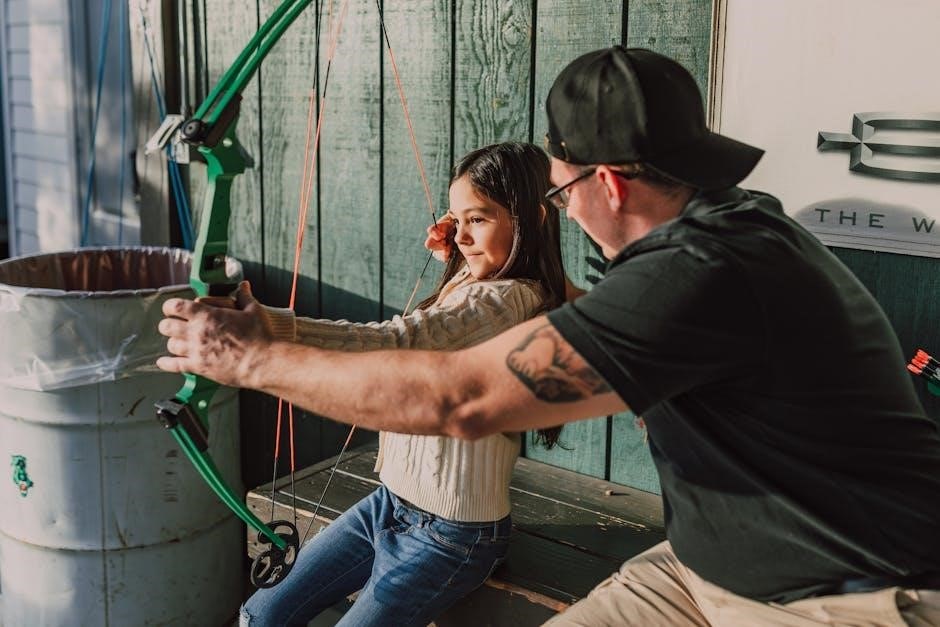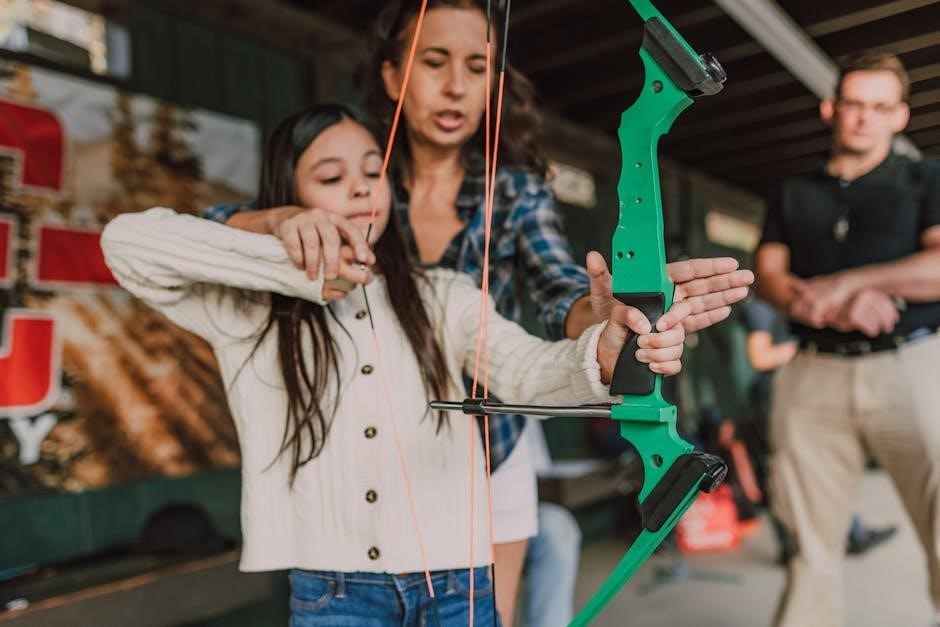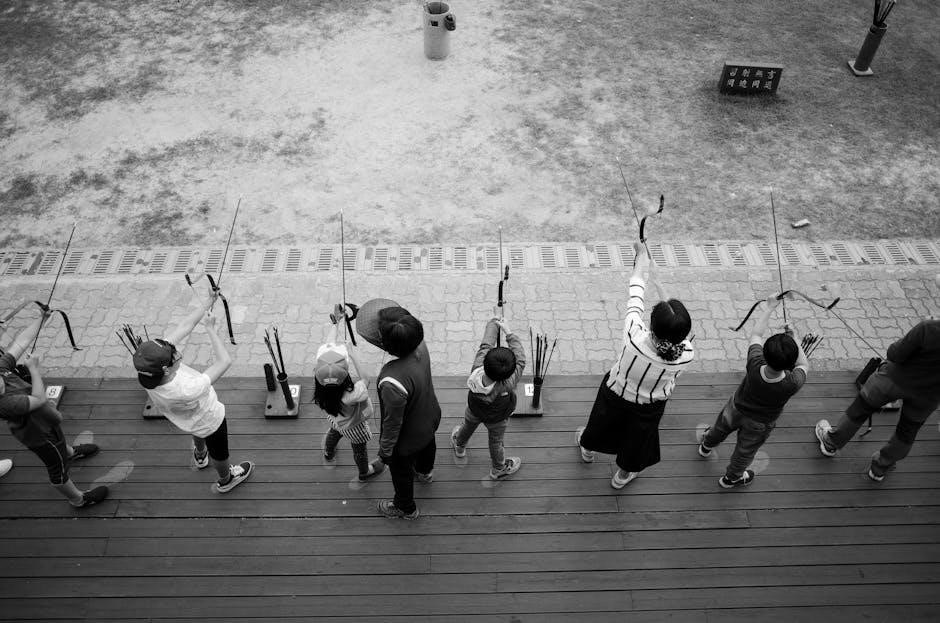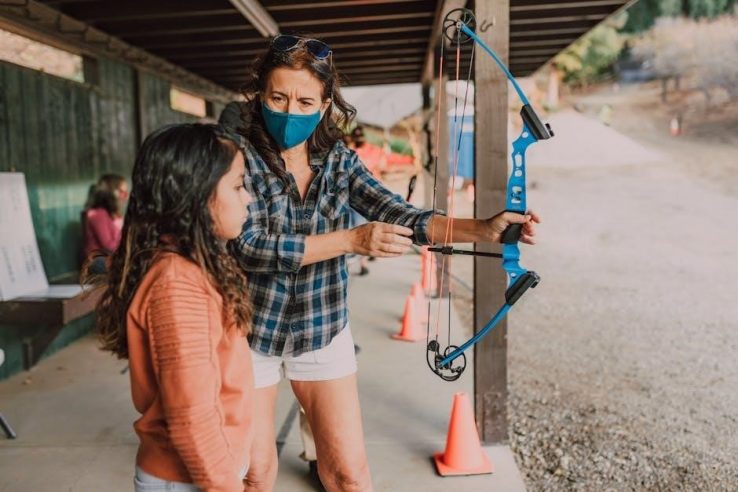Archery instruction certification ensures instructors possess the knowledge and skills to teach safely and effectively, providing a structured approach to archery education and promoting best practices.
1.1 Importance of Certification for Archery Instructors
Certification is crucial for archery instructors as it ensures they possess the necessary knowledge and skills to teach safely and effectively. It validates their expertise, enabling them to provide high-quality instruction while minimizing risks. Certified instructors are better equipped to address student needs, ensuring proper form and technique. This not only enhances the learning experience but also builds trust and credibility. Additionally, certification often unlocks career opportunities, as many organizations require instructors to be certified to lead programs or coach competitively.
1.2 Overview of the Certification Process
The certification process for archery instructors typically involves enrolling in a structured program, completing prerequisites, and participating in hands-on training. Courses are designed to equip instructors with essential skills in range safety, equipment handling, and teaching techniques. The process often includes a combination of theoretical and practical assessments to ensure competence. Upon completion, instructors receive certification, validating their ability to teach archery safely and effectively. This process ensures that instructors are well-prepared to lead archery programs and provide high-quality instruction to students of all skill levels.

Benefits of Archery Instruction Certification
Archery instruction certification enhances teaching skills, improves safety awareness, and expands career opportunities, while also building confidence and credibility as a qualified archery instructor.
2.1 Enhanced Teaching Skills
Archery instruction certification equips instructors with advanced teaching methodologies, enabling them to communicate complex techniques clearly and adapt to diverse learning styles. Certified instructors gain expertise in demonstrating proper form, breaking down skills into manageable steps, and providing constructive feedback. This training fosters a supportive learning environment, ensuring students progress effectively while maintaining engagement and fun. Enhanced teaching skills also include lesson planning strategies and the ability to address individual needs, making instructors more versatile and confident in their instructional roles.
2.2 Increased Safety Awareness
Archery instruction certification emphasizes safety protocols, ensuring instructors can create a secure learning environment. Certified instructors learn to identify and mitigate risks, properly set up ranges, and implement emergency procedures; They gain expertise in equipment inspection, proper shooting form, and supervising students to prevent accidents. This heightened awareness not only protects participants but also builds trust and confidence in the instructional process, making safety a top priority in every archery session.
2.3 Career Opportunities in Archery Instruction
Archery instruction certification opens doors to diverse career opportunities, enabling individuals to coach at various levels, from youth programs to elite training. Certified instructors can work in archery shops, schools, or sports clubs, offering lessons and workshops. Higher certification levels, such as Level 2 or NTS, allow instructors to mentor other coaches and lead advanced training programs. This credential also enhances credibility, making instructors more competitive in the job market and eligible for roles in archery organizations or competitive teams.

Types of Archery Instruction Certifications
Archery instruction certifications range from basic to advanced levels, including Level 1, Level 2, and Level 3, with specialized options like the National Training System (NTS) for expert coaches.
3.1 Level 1 Instructor Certification
The Level 1 Instructor Certification is an entry-level program designed for individuals new to archery instruction. It focuses on foundational skills, including range safety, equipment basics, and teaching methods. Participants learn to conduct beginner sessions safely and effectively. This certification is ideal for camp counselors, school teachers, and community recreation staff. The course typically covers essential topics like range setup, shooting form, and lesson planning. Upon completion, instructors are equipped to teach basic archery skills to novices, ensuring a safe and enjoyable experience for all participants. This certification is the first step in building a career in archery instruction and is a prerequisite for advanced levels.
3.2 Level 2 Instructor Certification
The Level 2 Instructor Certification is an intermediate program designed for individuals with prior archery experience. It builds on the foundational knowledge of Level 1, focusing on advanced coaching techniques, mental training, and equipment customization. Participants learn to improve archers’ techniques, address common issues, and adapt instruction for different skill levels. This certification is ideal for those aiming to coach intermediate archers or work in structured archery programs. It requires a higher level of expertise and is a prerequisite for progressing to Level 3 certification.
3.3 Level 3 Instructor Certification
The Level 3 Instructor Certification represents the highest standard in archery instruction, focusing on advanced coaching methodologies and specialized techniques. This certification is tailored for experienced instructors who aim to work with elite or competitive archers. It emphasizes detailed technical analysis, personalized training plans, and mental performance strategies. Candidates must demonstrate a deep understanding of biomechanics, equipment tuning, and competitive strategies. This certification is essential for those seeking to coach at the national or international level, ensuring they can prepare athletes for high-level competitions effectively.
3.4 National Training System (NTS) Certifications
The National Training System (NTS) Certifications are advanced credentials designed for instructors seeking to specialize in high-performance archery coaching. These certifications focus on biomechanics, mental preparation, and competitive strategies. NTS-certified instructors are equipped to train elite archers, emphasizing precision, efficiency, and peak performance. This system is ideal for those working with competitive athletes, offering in-depth training on advanced techniques and personalized coaching methods. It builds on foundational certifications, requiring a high level of expertise and practical experience in archery instruction and competitive training environments.

How to Get Certified
Obtaining archery certification involves enrolling in approved courses, completing prerequisites, and passing assessments. Training covers safety, equipment, and teaching methods to ensure comprehensive preparation for instructors.
4.1 Finding a Certification Course
Finding a certification course involves researching reputable organizations offering archery instruction programs. Many archery associations provide instructor training, such as USA Archery or the National Archery in the Schools Program (NASP). These organizations often list certified trainers or course schedules on their websites. Additionally, local archery clubs or pro shops may host or recommend certification courses; It’s important to ensure the course is accredited and aligns with your career goals in archery instruction.
4.2 Prerequisites for Certification
Prerequisites for archery certification vary by level but typically include age requirements, basic archery knowledge, and completion of prior training. For Level 1 certification, candidates often need to be at least 15 years old and demonstrate foundational archery skills. Higher levels may require previous certifications or coaching experience. Some programs also mandate first aid training or background checks, ensuring instructors are qualified and safe to teach. These prerequisites ensure a standardized approach to developing competent archery instructors.
4.3 Course Structure and Duration
Archery certification courses combine classroom instruction with hands-on training, covering topics like range safety, equipment maintenance, and shooting techniques. The duration varies, typically ranging from a few days to several weeks, depending on the certification level. Basic courses might last 1-3 days, while advanced programs can extend up to several weeks. The structure ensures comprehensive skill development, blending theoretical knowledge with practical application to prepare instructors for real-world teaching scenarios. This balanced approach ensures instructors are well-equipped to manage archery programs effectively.
4.4 Certification Exam and Assessment
The certification exam evaluates both theoretical knowledge and practical skills, ensuring instructors meet standardized criteria. It typically includes a written test on safety protocols, equipment knowledge, and teaching methodologies, followed by a practical demonstration of archery techniques and lesson delivery. Candidates must achieve a minimum passing score, often 80%, to become certified. The assessment ensures instructors are competent in both archery fundamentals and instructional strategies, maintaining high standards for teaching the sport safely and effectively.

Course Content for Archery Instruction Certification
Course content covers range safety, shooting techniques, equipment maintenance, and lesson planning, providing instructors with comprehensive knowledge to teach archery effectively and safely.
5.1 Range Safety and Setup
Range safety and setup are critical components of archery instruction certification. Instructors learn how to create a safe shooting environment, including proper arrow aisle and target line setup. They are trained to enforce safety protocols, such as ensuring all archers wear proper gear and follow range rules. Additionally, instructors are taught how to inspect equipment for damage and ensure the range is free from hazards. Proper supervision techniques are emphasized to prevent accidents, making this module essential for maintaining a secure and organized archery range.
5.2 The Steps of Shooting
The steps of shooting module focuses on teaching proper archery technique. Instructors learn to guide students through stance, grip, anchor, drawing, aiming, and releasing. Emphasis is placed on consistent form and follow-through to ensure accuracy and safety. This module also covers how to identify and correct common errors, helping archers improve their performance. By mastering these steps, instructors can effectively teach students of all skill levels, from beginners to advanced archers, ensuring a solid foundation in shooting technique and proper execution.
5.3 Equipment Maintenance and Repair
This module trains instructors to inspect, maintain, and repair archery equipment. Topics include checking bows for damage, string replacement, and arrow care. Instructors learn to lubricate moving parts, inspect arrow nocks, and replace fletching. Proper storage techniques are also covered to prevent equipment damage. Understanding equipment maintenance ensures instructors can provide safe, functional gear for students, promoting reliability and performance. Regular inspections and repairs help extend equipment lifespan, making this knowledge essential for effective archery instruction and a safe learning environment. Instructors also learn to identify when professional repair is needed.
5.4 Lesson Planning and Delivery
Effective lesson planning and delivery are crucial for archery instruction. Instructors learn to create structured, engaging lesson plans tailored to diverse student needs. Key components include safety protocols, step-by-step shooting instructions, and demonstrations. Hands-on practice and feedback are emphasized to ensure skill progression. Instructors also learn to adapt teaching methods to accommodate different learning styles and skill levels. This module ensures instructors can deliver comprehensive, safety-focused lessons, fostering student confidence and mastery of archery fundamentals. Proper delivery techniques help maintain student engagement and promote a positive learning environment.
Safety Protocols in Archery Instruction
Safety protocols ensure a secure environment for archery practice, emphasizing proper equipment handling, range setup, and emergency preparedness to minimize risks and protect participants effectively.
6.1 Best Practices for Range Safety
Best practices for range safety include proper setup, clear shooting lines, and supervision by certified instructors. Always inspect equipment, ensure archers are positioned correctly, and maintain a safe distance from bystanders. Use backstops and netting to contain arrows, and designate a waiting area for non-shooting participants. Establish a pre-shooting safety briefing and enforce strict no-shooting zones. Proper signage and emergency procedures should be in place to handle any incidents promptly and effectively, ensuring a secure environment for all archery activities.
6.2 Emergency Procedures
Emergency procedures are crucial for ensuring prompt and effective responses to incidents during archery instruction. Instructors should be trained in first aid and know how to handle arrow-related injuries, such as proper removal techniques. A first aid kit must always be on hand, and emergency contact information should be easily accessible. In case of serious injuries, immediately call emergency services and evacuate the area if necessary. Regular drills and clear communication ensure everyone is prepared to act swiftly, minimizing risks and ensuring a safe learning environment for all participants;
6.3 Risk Management
Risk management in archery instruction involves identifying potential hazards and implementing strategies to minimize them. Instructors should assess risks such as equipment failure, improper form, and environmental factors. Developing clear safety protocols and emergency response plans is essential. Regular equipment inspections and proper supervision can prevent accidents. Training instructors in risk assessment and safety best practices ensures a secure environment for students. Additionally, ensuring proper insurance coverage and adhering to legal requirements further mitigates potential risks, creating a safer and more responsible teaching environment for archery instruction.

Teaching Techniques for Effective Archery Instruction
Effective archery instruction involves clear communication, demonstrating proper form, and providing constructive feedback to students, ensuring they develop skills safely and confidently under expert guidance.
7.1 Communicating with Students
Effective communication is key to successful archery instruction. Instructors should use clear, concise language to explain techniques and provide feedback. Active listening helps understand student needs, while positive reinforcement builds confidence. Adapting communication to individual learning styles ensures comprehension. Encouraging questions fosters engagement and clarifies doubts. Demonstrating patience and empathy creates a supportive environment, allowing students to progress at their own pace. Clear communication enhances learning outcomes and ensures a safe, enjoyable experience for all archers.
7.2 Demonstrating Proper Form
Demonstrating proper archery form is essential for student learning and safety. Instructors should model correct stances, grips, and shooting techniques to ensure students understand proper mechanics. Breaking down each step visually helps students mimic the movements accurately. Using visual aids and real-time feedback enhances comprehension. Emphasizing alignment, balance, and control minimizes the risk of injury and improves accuracy. Consistent demonstrations reinforce proper form, helping students develop good habits from the start. Clear, precise examples are vital for effective skill acquisition in archery training.
7.3 Providing Feedback
Providing constructive feedback is crucial for improving archery skills and boosting student confidence. Instructors should offer specific, timely, and actionable advice, focusing on technique, posture, and equipment use. Positive reinforcement for correct actions encourages repetition, while gentle corrections guide improvement. Feedback should be clear and concise, avoiding vague statements. Using visual cues and demonstrations alongside verbal feedback enhances understanding. Regular assessment allows students to track progress and stay motivated, fostering a supportive and effective learning environment tailored to individual needs and skill levels in archery training.
Marketing Yourself as a Certified Archery Instructor
Highlight your certification, skills, and experience to attract students. Use social media, create a professional website, and network with local archery clubs to promote your services effectively.
8.1 Building a Professional Network
Building a professional network is crucial for certified archery instructors. Connect with local archery clubs, pro shops, and organizations to gain visibility and referrals. Attend workshops, tournaments, and events to meet fellow instructors and potential students. Join online forums and social media groups dedicated to archery to expand your reach. Collaborate with sports equipment stores or community centers to offer joint promotions. A strong network can lead to new opportunities, partnerships, and a steady flow of students eager to learn from a certified expert.
8.2 Promoting Your Services
Promoting your services as a certified archery instructor requires strategic marketing. Create a professional website showcasing your certifications, experience, and class offerings. Use social media platforms like Instagram and Facebook to share engaging content, such as archery tips and success stories. Distribute flyers in local sports shops, schools, and community centers. Leverage email marketing to reach potential clients and collaborate with archery equipment retailers for cross-promotion. Highlight your certification and unique teaching style to stand out in the competitive market and attract a loyal student base.
8.4 Creating a Lesson Plan
Creating a lesson plan is essential for structured archery instruction. Start with clear objectives, such as teaching proper stance or aiming techniques. Include safety protocols and equipment checks at the beginning. Break the session into demonstrations, hands-on practice, and feedback. Tailor exercises to student skill levels, ensuring progression from basic to advanced skills. Conclude with a review of key points and preview the next session. This structured approach ensures effective learning and keeps students engaged, helping them build confidence and proficiency in archery.
Advanced Certifications and Continuing Education
Advanced certifications and continuing education help instructors refine their skills, stay updated on techniques, and specialize in specific archery disciplines, enhancing their coaching expertise and professional growth.
9.1 Advanced Coaching Techniques
Advanced coaching techniques in archery instruction certification focus on refining high-performance strategies, biomechanical analysis, and mental training. These methods, often covered in Level 3 certifications and NTS programs, emphasize personalized coaching to optimize athlete performance. Instructors learn to adapt techniques to individual archers’ needs, focusing on precision, consistency, and mental resilience. These advanced strategies are essential for preparing archers for competitive environments and ensuring continuous skill development. They build on foundational knowledge, offering specialized tools for elite-level coaching and fostering excellence in the sport.
9.2 Specialized Archery Disciplines
Specialized archery disciplines expand instructors’ expertise beyond basic archery techniques, covering niche areas like Olympic Recurve, Compound archery, and Traditional archery. These certifications often delve into specific equipment, shooting styles, and competitive formats. For example, instructors may learn to teach 3D archery, field archery, or historical archery styles. These specialized programs allow instructors to cater to diverse student interests and skill levels, enhancing their versatility and appeal as coaches. They also provide deeper insights into equipment customization and advanced shooting practices for specific disciplines.
9.3 Staying Updated with Industry Trends
Staying updated with industry trends is crucial for archery instructors to remain relevant and effective. Continuous learning through workshops, webinars, and industry publications ensures instructors are informed about the latest techniques, equipment, and best practices. By engaging with professional networks and attending conferences, instructors can gain insights into emerging trends, such as new training methods or technological advancements in archery equipment. This commitment to ongoing education not only enhances their teaching skills but also ensures they provide students with the most current and competitive knowledge in the sport.
Archery instruction certification is a valuable investment for instructors, enhancing safety, teaching skills, and career opportunities while fostering a deeper understanding of the sport.
10.1 Summary of Key Points
Archery instruction certification is essential for ensuring safety, enhancing teaching skills, and advancing career opportunities. It provides instructors with a comprehensive understanding of archery fundamentals, including range safety, equipment maintenance, and effective lesson delivery. Certification levels (1-3 and NTS) offer progressively advanced training, preparing instructors to teach various skill levels and specialized disciplines. By obtaining certification, instructors gain credibility, improve student outcomes, and contribute to the growth of archery as a sport. This structured approach ensures high standards in archery education and fosters a supportive learning environment for all participants.
10.2 Final Thoughts on Archery Instruction Certification
Archery instruction certification is a valuable investment for anyone passionate about teaching and promoting the sport. It equips instructors with the knowledge, skills, and confidence to create safe and engaging learning environments. By fostering growth and excellence, certification helps build a community of skilled archers and dedicated educators. The process not only enhances personal expertise but also contributes to the sport’s evolution. Ultimately, pursuing certification is a rewarding journey that benefits both instructors and students, ensuring archery continues to thrive as a beloved activity for generations to come.
